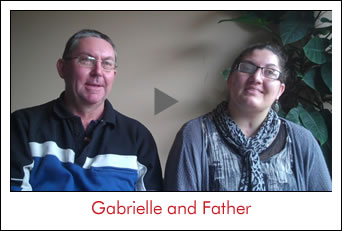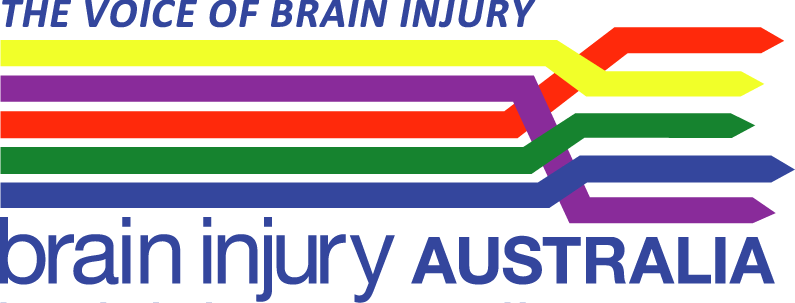- MODULE 1: Introduction to ABI
- Module Introduction
- Take the Pre-test
- a) A person’s abilities & life span
- b) What is ABI?
- c) Causes of ABI
- d) Incidence
- e) The brain
- f) Severity of ABI
- g) Cause to impact
- h) Rehabilitation
- i) Rehabilitation stages & pathways
- j) Common effects
- k) Impacts on life
- l) People with ABI
- m) Family and friends
- n) Key messages and
Tools to explore in Module 2 - o) Building skills
- Take the Post-test
i) Rehabilitation stages and pathways 
- i) Introduction
- ii) Gabrielle has
an ABI: Video Q - iii) Rehabilitation
stages - iv) General & specialist
rehabilitation - v) Pathway
Example
i) Introduction
There are many rehabilitation pathways.
When a person has an ABI there are many different rehabilitation pathways depending on the cause of the ABI and point in the life span the injury occurred and the person's circumstances. For example:
- An adult with a serious traumatic brain injury could have the following pathway: Hospital Brain Injury Rehabilitation Unit; discharge to supported accommodation; community rehabilitation services
- An adult with a serious stroke could have the following pathway: Hospital Stroke Unit; discharge to family home; community rehabilitation services
- An adult with ABI caused by degenerative diseases could have the pathway: GP; medical specialists; outpatient services; support services in the home; specialist supported accommodation
Rehabilitation pathways for hospital for sudden onset ABIs
The first screen (0) of the following graphic shows the many elements that can be part of rehabilitation pathways for hospital for sudden onset ABIs.
Four examples:
Screens 1 to 4 show examples for four individuals:
1. Acute hospital bed to Brain Injury Unit (less complex/severe case)
2. Acute hospital bed to Brain Injury Unit (more complex/severe case)
3. Stroke unit
4. Acute hospital bed to Brain Injury Unit (very complex/severe case)
The graphic may take a few moments to load. See instructions below.
Click on "Person with ABI" to click through the screens.
Click on the Individual numbers 0 to 4 to jump to a particular screen.
ii) Gabrielle has an ABI (11 mins)
Gabrielle has an ABI
Watch Gabrielle's short story.
Click on the image to go to the video player.
Answer the question
What are the stages in Gabrielle's story?
iii) Three stages of rehabilitation
For all types of injuries the three stages of rehabilitation are:
Stage 1: Acute rehabilitation
This acute stage involves initial management to ensure the person is medically stable. Acute rehabilitation normally occurs within hospital with a strong focus on physical recovery and regaining independent living skills.
Stage 2: Post-acute rehabilitation/community re-settlement
This stage involves managing the transition from hospital back home, and the ongoing process of rehabilitation that occurs after discharge. The focus of rehabilitation at this stage may include return to work or study, finding alternatives where this is not possible and relearning skills for community living.
Stage 3: Social rehabilitation
This is the long-term rehabilitation aimed at maintaining and enhancing the level of participation in community life (community integration).
Within these three stages there are:
General rehabilitation processes and
Specialist rehabilitation processes.
iv) General and specialist rehabilitation
General rehabilitation
Inpatient rehabilitation services have a primary goal of restoring, improving and maintaining the functional ability of the patients, ensuring they can be safely discharged with the assistance of equipment, aids and modifications to their home.
Functional ability relates to carrying out tasks of daily living including personal hygiene, self-bathing, feeding, toileting, stair climbing, dressing, bowel and bladder control, ambulation, chair and bed transfer, and walking or wheelchair use.
General rehabilitation wards in public hospitals provide a multidisciplinary approach (involving medical nursing and allied health services) for people who have a variety of medical reasons for needing rehabilitation (e.g. orthopaedic/amputee; cardiac/heart attacks; neurological/stroke; trauma, pain, post operative etc).
The majority of clients admitted to general rehabilitation wards are elderly.
Specialist rehabilitation
Specialist rehabilitation services are required when the needs of a specific client group are better managed by providing discrete services to meet similar needs.
Specialist rehabilitation services are managed within general rehabilitation by providing staff with specialist training (e.g. cardiac rehabilitation, stroke rehabilitation) or by organising rehabilitation services into dedicated units e.g. the NSW Brain Injury Rehabilitation Program (BIRP), Stroke services or Spinal Cord services to develop expertise in providing specialist rehabilitation to meet the specific needs of the client group.
(c) Copyright - See: Toolkit B. Working Together Promoting Independence - www.TBIStaffTraining.info
v) Pathway example
Service pathways vary from one person with ABI to another. To understand an individual's service pathway it is useful to understand: a) The person's injury and their personal journey of recovery and rehabilitation, b) Typical service pathways and c) Typical funding pathways for rehabilitation and support services.
an examples of a typical service pathways is:

What is a typical service pathway?
The exact service pathway will vary from person to person.
A typical service pathway for sudden onset ABI for serious injury is:
- The injury event
- Emergency services
- Hospital acute care
- Hospital rehabilitation
- Discharge planning and discharge to the community
- Living in the community - often with ongoing rehabilitation and out-patient services
In the community the person could be living independently in their own home, alternatively they could require supports to live in their home and access the community and community services.
There are multiple sources of funds that the person may potentially be able to access to pay for the services and supports they require to live independently in the community.


